It is a question that divides breeders. On one side you have expert breeders like Bernard le Courtois, who clearly separates the two. In his comments on a great performer and a great breeding stallion, Dollar du Murier, Bernard has this to say in the 2008 edition of Monneron.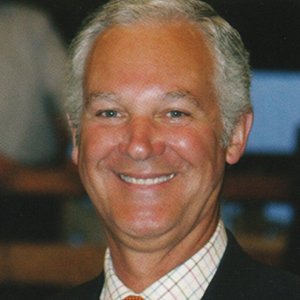
“Dollar du Murier, as his sire before him, has a reputation of producing horses that are too difficult for amateur riders. But what stallion with a reputation for producing high-level stars also turns out riding hacks for gentrified ladies to ride in the Bois de Boulogne? There are many other stallions for this purpose.”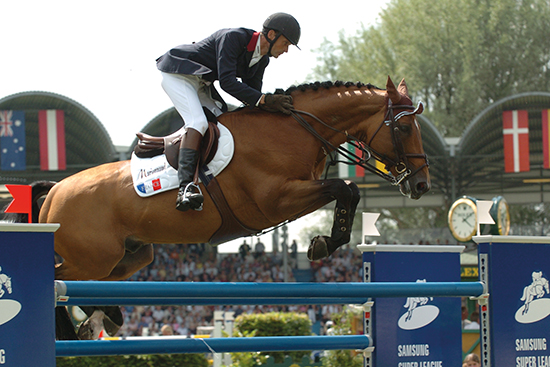
Dollar du Murier – not the sire of ladies’ hacks…
“Dollar has to be taken as he is… a star capable of producing stars! His sire, Jalisco was the same; was it not said of Jalisco that he could turn out a Grand Prix horse, or a hunter… but nothing between the two.”
On the other hand, an equally respected French breeder, Arnaud Evain (indeed a partner with le Courtois in the prestigious Fences auction) takes the other view:
“It is not two markets. A champion is a meeting of a better than average horse, and good luck. We have recently bred the European Champion, Kraque Boom Bois Margot, and at the end of the day he became the European Champion, not because of the choice of the father and the mother, not because of all the good training, but also because Okidoki missed the first fence in the final – otherwise, he would have been the silver medalist and everyone would have forgotten him.”
But if he hadn’t become a championship competitor, would he have been a nice horse for your wife to ride out in the forest on a loose rein?
“Probably yes. It is a question of education. I have a good friend who is a lawyer and he has one of the most successful horses in the world, which has achieved more than 70 victories internationally in three star CSIs and above, with Roger-Yves Bost, his name is Jovis de Revel, and my friend rides the horse all week, and Roger-Yves Bost rides him only at the weekends. With the champions you can find examples and counter-examples. A champion is an accident.”
The breeding director of the Oldenburg Verband, Dr Wolfgang Schulze-Schleppinghoff feels that the divide is more one of discipline:
“The greatest difference in my eyes is between the horse for jumping competitions or dressage, that is the great division, but the horse should be the same for the fun rider as the Olympic rider. It is not the level of competition so much as the question of dressage or jumping.”
People often say, for example with the Jazz horses, that these are horses for the professional… do they need to be a little crazy to go to the top?
“Okay but remember Rubinstein, he was easy to ride and he makes horses for amateurs and for professional riders too. With Jazz, maybe some stallions have high quality but their progeny are not so easy to ride, but we have to breed, in my opinion, horses like Rubinstein, that have the possibility to go in the highest level, and also horses for the amateur rider.”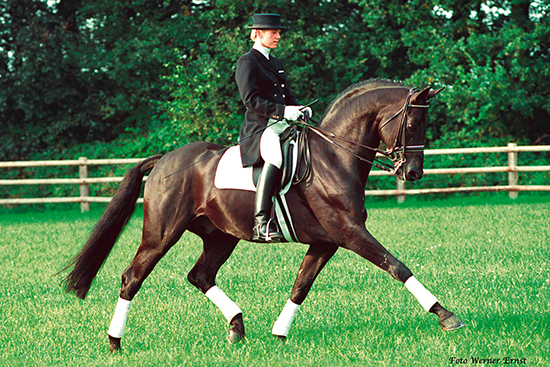
Rubinstein – great horses, great temperament
But even Martina Hannover who rode Rubinstein, says that he did not have enough movement to be a Grand Prix winner now… When we see horses like Totilas with this extraordinary action, have we moved into a new zone?
“Maybe you are right. It is very very difficult to have everything in one horse. You have to make compromises, that’s clear, but if we breed only for Olympic riders that are less than 1%, that is a problem – what do we do with the rest of the horses who are not of a very high quality but have a complicated temperament? In Germany we think we need horses that are good in temperament even more than movement.”
And with the jumping horses – there are many people who say with the high standard of the courses today, the top jumpers are a little crazy?
“Perhaps this is so with the jumpers – I would say that a top jumper must be a little bit different, and they must have a lot of courage, but with dressage horses, I would say they must be for every rider, but for a jumper it is more specialized.”
Dutch breeding expert – and leading horse dealer – Paul Hendrix feels it depends on the particular stallion:
“I am a professional, and if I buy a young horse or a foal, you cannot know all the answers, so you have to always look on the down-side, and with a stallion like Indoctro, it is easy, you know there is always a positive downside in the form of a great amateur horse. Indoctro produces from Olympic and World Cup finalists to a fantastic amateur horse with fantastic riding qualities and fantastic minds.”
Are some of the really top horses too crazy for the amateur?
“No – Look at the horses of Indoctro – a very good mouth, very good balance in the canter, great attitude to the jumps are what make a special horse for the top and the amateur: great attitude, fantastic balance, rideability that’s what you get from Indoctro. But some other stallions, are not so easy, but I will not say they are crazy.”
You wouldn’t want to go for a nice ride in the country on Shutterfly, I guess…
“Exactly, you hit it in one, but with Indoctro, you can always do it.”
American jumping guru, and the man who introduced the European bred horse to the US jumping scene, George Morris makes much the same point:
“If I wanted to breed a horse for my aunt, I wouldn’t go to the Thoroughbred Forrest line of Shutterfly, I wouldn’t think of touching that horse for my hack. Some horses, maybe Sapphire, if you had big bucks, would be a lovely adult jumper for somebody. It depends on the type and the temperament. If you are not sure what you want to do, I would breed the best to the best because if you are over-horsed, you can always sell it and buy another one, rather than if you are under-horsed, then you can never get rid of it.”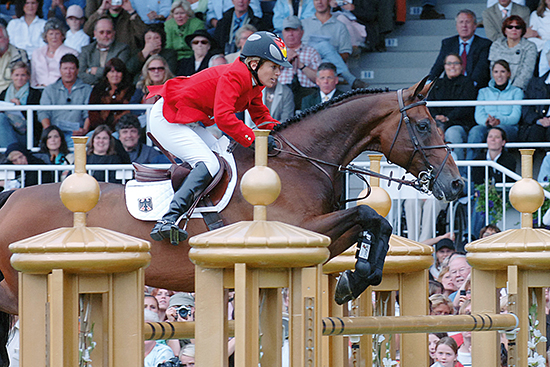
Shutterfly – not the best choice for your Aunt to ride…
What is Authentic like to ride?
“The first time I ever rode him, John and Beezie Madden wanted to buy him, it was the first of January, very cold and windy, and I said, this is a very fresh, very hot horse, and I am going to get bucked off on my arse, or he is going to run off with me. I ride him quite a bit, and yes, he is hot, very sensitive but he is also very steady. He is like a Thoroughbred, he is not for a dummy to ride.”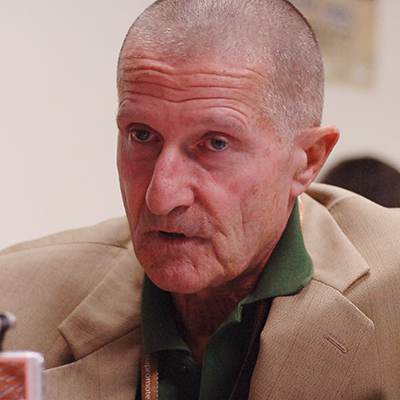
Ulf Möller has produced some of the world’s most exciting young dressage horses, including the World Champion, Sandro Hit, and in his role as manager of the PSI dressage barn in Hagen, Germany, he is producing for a wide spectrum of the market, and he has been giving the question a deal of thought:
“It is a question we are discussing a lot in Germany at the moment because if you talk about breeding, you also have to talk about the market, and the market for top horses that are a little bit difficult is smaller than the market for well-trained, easy-to-ride horses. So normally the answer must be, you should breed easy horses, willing horses, sound horses… and then the exception is the top horse. But to say this is against what I would like to see. I like to see the impressive horses with huge gaits, everyone likes this, but to train them on, then less gaits is often easier.”
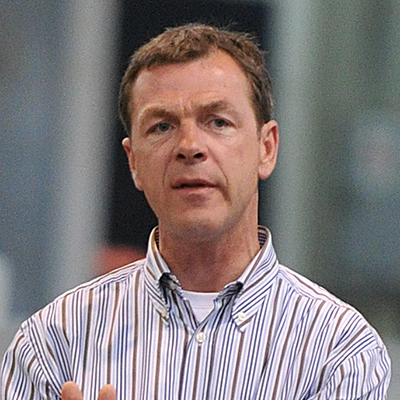 “I don’t think you can look at a three or four year old horse and say this is the next Olympic winner, no one can say that, because when you see the horse, you don’t know about the intelligence, the willingness to work, the trainability, the willingness in the end to take the pressure. What I often say is that there are more people who could run 100 metres in under ten seconds but not so many of them are willing to do this hard training. This is also very important with the horse, the horse must be willing to take this pressure… after two hours of work, they will still piaffe. But often in the beginning when they are young, these horses are for normal rider a little too difficult. If you have such a diamond, then you have to find the right rider for this horse, then you have a nice couple and you can start to hope this horse will go up all the levels.”
“I don’t think you can look at a three or four year old horse and say this is the next Olympic winner, no one can say that, because when you see the horse, you don’t know about the intelligence, the willingness to work, the trainability, the willingness in the end to take the pressure. What I often say is that there are more people who could run 100 metres in under ten seconds but not so many of them are willing to do this hard training. This is also very important with the horse, the horse must be willing to take this pressure… after two hours of work, they will still piaffe. But often in the beginning when they are young, these horses are for normal rider a little too difficult. If you have such a diamond, then you have to find the right rider for this horse, then you have a nice couple and you can start to hope this horse will go up all the levels.”
When you look at a pedigree do you say oh that is a horse for the amateur, or that is a horse for the professional?
“I know full brothers and they are totally different horses. I think only from the breeding you cannot say this, you must see the horse. For sure, there are some bloodlines that give more rideability than others, but like everything in life, you cannot comment before you see the horse.”
You sell quite a few Grand Prix horses through your auctions?
“We have a little bit the advantage that we start this work in hand with the four year old horses, and the horses learn this diagonal movement, and right from the beginning you can see some horses are more talented, and some horses don’t have this talent for piaffe. I think all horses can learn the idea of piaffe, but in the end it is a question of the style, and the style is talent – how they do it. Do they really jump from one leg to the other? Is it the piaffe we really want to see? But remember, Grand Prix is not only piaffe and passage, it is also good gaits, good front legs, good changes, good pirouettes – balance, intelligence, rideability. For a dressage horse it is 40% quality and 60% training, and maybe with the jumping horse, it is the other way round, 60% quality and 40% training, which means you can have a good average three year old, but with good training and riding they become a very nice horse.”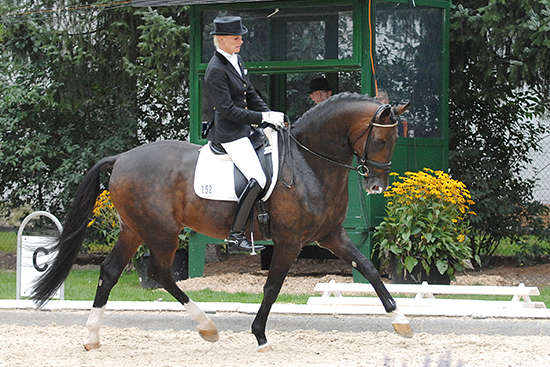
Brigitte Wittig and Brioni – breeding horses to ride yourself
Wolfram Wittig is unique in that he is a Grand Prix dressage rider himself, and trainer of some of the world’s most successful competitors – including Isabell Werth, while at the same time he and his wife, Brigitte, have bred and produced a enormously successful line of home bred dressage horses, most by their own stallion Breitling, that have competed successful both in young horse classes and in Grand Prix. Wolfram feels that there are dangers in the present breeding trends:
“So many dressage riders are asking for hotter horses, okay we can focus on that and breed in that direction, but if the horses don’t reach the top sport level, and they are still hot, what are you doing with these horses? Then they are dangerous to the riders if they are not good enough… We must have really talented horses with good movement, good character for the top level, and if they are only hot with no movement – what are they going to do with them?”
But people say this often, that the horse for the Grand Prix must be a bit crazy and not a horse the normal rider can ride, do you agree with this?
“No. A good horse is still a good horse. A very good example is Satchmo. Satchmo is never scared. He goes in all prize-givings, every time, beautiful walk, he was never scared. You ask Isabell, if she would select one of her horses to go out on the field, she would take Satchmo.”
Satchmo – he’s cool!
So you don’t think there are two sorts of horses we breed for – the horse for the housewife to ride in the fields and the other, the horse for Isabell to win a gold medal…
“The horse must be useful for everybody, and then depending on the quality of the movements, we can decide what to do with the horse.”
They don’t have to be crazy to go Grand Prix?
“I don’t think so. If you want to reach a high level, you don’t ask for crazy, because if you can’t control it, it is like a bomb. The Grand Prix horse should be good in the mind, and we should be focused on breeding that, otherwise we are taking the wrong direction. If riding is dangerous, we will lose our acceptance in the future. If everyone says to ride we must have crazy horses, and everyone is saying, be careful, please be careful, it is not acceptable. If you cover a mare, you don’t know what the result will be – you can have your plans, but if they want only hot horses, then they can ride Thoroughbreds – they are hot enough – but no-one is asking for that. They say ‘oh no, the movements are not good enough!’ – so we have to find the way in the middle, but the horse must be useful for everybody. Then it depends on the training, which classes they are reaching, but it is not possible to breed exactly a Grand Prix horse, definitely not possible.”
“If you ask ten riders to describe a Grand Prix horse, you will have ten different horses. Taller, smaller, bigger, heavier, male, female… so for whom should you breed the horse? At the moment you are breeding, your client is not there!”

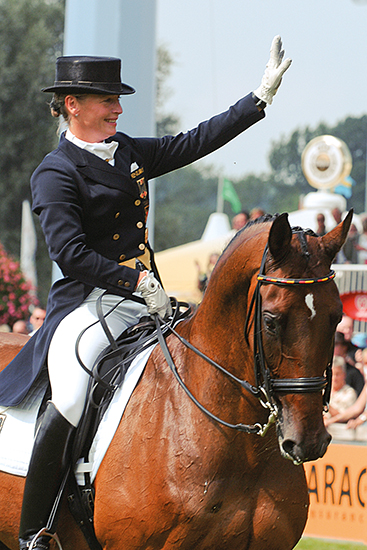
Love this. I remember years ago having this same discussion on the COTH dressage discussion board. I’ve always felt that you breed to produce the best horse you can for a specific discipline. That means considering all the elements that make a top performer, not just one or two of them. As a breeder of dressage horses, I always tried to produce a horse better than my mare in terms of conformation, gaits, AND temperament.
This is an excellent article with thoughtful comments from both points of view. I tend to align with those who believe we should breed same horse for the housewife as the top competitor. The key word to ascribe importance to is “character”. The fractious, overly sensitive horse is not a horse of good character, but by the same token, neither is the lazy, hard to motivate one. A horse of good character is simply a horse that is a trustworthy, willing partner, and statically, some of these will be talented at their sport while others won’t. Regardless, the redeeming quality of good character is this: with or without talent, the animal is a pleasure to be around. The talented ones with proper training will no doubt rise to the top of their sport, and the not so talented ones, because of that indispensable quality of “good character”, thank goodness, will be available to pack our children around.
Im going to ripple the waters a little here and say, firstly “housewives” are not the only people who enjoy leisure riding, and secondly many are excellent riders. You choose your horse because you like what you see and feel and this applies to any rider, top professional or leisure rider. So all kinds of horses are needed. Many leisure riders are extremely skilled even if they’re not living in Hotels, trailers and planes all year chasing ribbons, it’s a lifestyle choice, this doesn’t mean they would necessarily settle for a wooden plank to sit on. They would also pay good money for a good horse. There are also top riders who would pass up on a horse if it was mad as a five year old, just as they might if it couldn’t do a simple canter change at six.
How many sports car drivers do you see on the road who will never sit in a Formula One car on a track. Come on, both sexes! They still fork out 400 00 dollars to drive a decent car.
I don’t think breeders should be worried about blood. There is a market for trekking ponies as is there a market for calm solid heavy warmbloods. Breed what ever interests you.
I’ve seen complicated crazier old style warmbloods that I wouldn’t get back on in a thousands years, horses that can only passage instead of trot that will gallop over a wet muddy ploughed field and back whether you wanted them to or not.
Are we breeding too many horses is a very real and pertinent question and do they mostly end up all living the life we intend for them as horses in this day and age of often extreme and ruthless commercialisation. Is it ethical for three and five year old championship classes when the horses are likely to only break down as a result of both the breeding and training?! Shouldn’t we respect the horse more and treat it less like a commodity, no more than auction fodder?
Ps- you’ve never met my Aunt, I dont think Shutterfly could’ve carried her never mind anything else. Shutterfly was the perfect gentleman in every respect! All in the training.